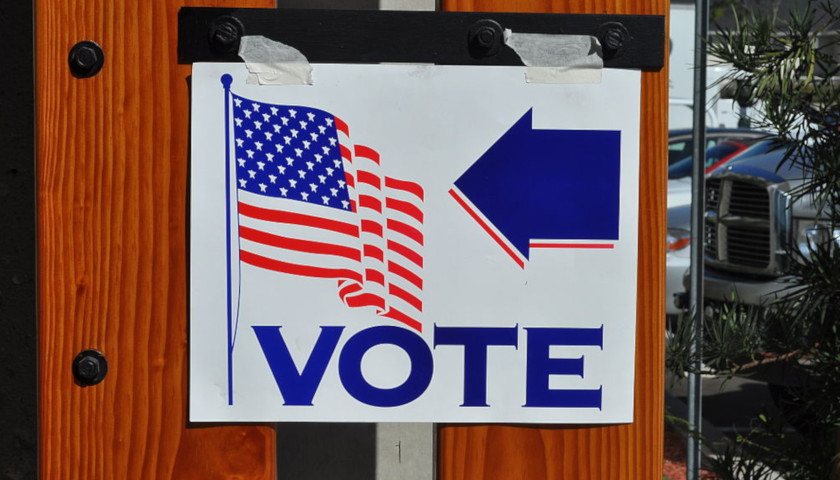by Edward Ring
A special election is scheduled for September 10 in North Carolina’s 3rd Congressional District to replace former incumbent Walter Jones, the long-serving Republican who died earlier this year. The district is solidly Republican. Jones earned twice as many votes as his Democratic challenger in nearly every election since he first took office in 1995.
But the district is interesting for another reason, one that every Republican strategist in America should study. It is one of 47 congressional districts in the United States where, in the 2018 midterm elections, a majority of nonwhite voters were projected to vote Republican.
 The following map, prepared by elections analyst Geoffrey Skelly at FiveThirtyEight, shows the congressional districts (red) where, if no one but nonwhite people voted, Republican candidates would still be likely to win.
The following map, prepared by elections analyst Geoffrey Skelly at FiveThirtyEight, shows the congressional districts (red) where, if no one but nonwhite people voted, Republican candidates would still be likely to win.
It’s hard to overstate the significance of these 47 congressional districts. They belie the smug certainty on the part of Democratic politicians and strategists across the United States who equate the demographic transformation of America with an inevitable and unbreakable Democratic majority.
Take mass nonwhite immigration, higher birth rates for nonwhites, mix in identity politics and leftist, race-centric indoctrination against “white privilege,” and voila, America becomes a one-party state.
Or does it?
What distinguishes these 47 congressional districts? All but 10 of them are in right-to-work states. The ones that are not are California’s 8th congressional district, Missouri’s 3rd, 4th, 7th, and 8th congressional districts, Ohio’s 6th and 8th congressional districts, and Pennsylvania’s 12th and 15th congressional districts. This might mean that the 37 congressional districts that are in right-to-work states lack a large union-funded political operation, which almost always supports Democrats.
What about the overall partisan control of the states where these 47 congressional districts are located? Here again there is a strong correlation: All but two—CA 8 and the 15th congressional district in Illinois—are in states where Republicans control the state legislature. All but seven—CA 8, IL 15, PA 12 and 15, Louisiana’s 4th and 6th congressional districts, and North Carolina’s 3rd congressional district—are in states where Republicans control the state legislature and the executive branch. Again, this suggests solid access to resources to run up the vote, to the point of convincing a majority of nonwhite voters to support a Republican.
There’s a lot to chew on here, but unless demographics is indeed destiny, whatever is happening in these 47 congressional districts needs to be digested. The average margin of victory by the Republican candidate in these districts for the 2018 election was 21 percentage points. Did Democratic nonwhite voters decide to stay home due to the fact that these 47 congressional districts were all ultra-safe Republican, with only those nonwhites who happened to be Republican showing up to vote? Only one district had a victory margin less than ten points, CA 8, where the Republican prevailed 54-46. Apart from that, only four districts—the 14th and 27th congressional districts in Texas, NC 3, and LA 4, had Republican margins of victory under 15 points.
 Other quantitative factors don’t seem to indicate very much. The overall proportion of white voters in these 47 districts is 77 percent compared to 72 percent overall. There is tremendous variation in ethnic composition among the 47 districts, however, with TX 27 (Corpus Christi) delivering a 13 point margin of victory to the Republican in the last election, despite only being 40 percent white (51 percent Latino). Moreover, districts with barely a white majority delivered huge margins in some cases; TX 11 (Midland) delivered a 32 percent margin of victory to the Republican, despite only being 51 percent white (38 percent Latino).
Other quantitative factors don’t seem to indicate very much. The overall proportion of white voters in these 47 districts is 77 percent compared to 72 percent overall. There is tremendous variation in ethnic composition among the 47 districts, however, with TX 27 (Corpus Christi) delivering a 13 point margin of victory to the Republican in the last election, despite only being 40 percent white (51 percent Latino). Moreover, districts with barely a white majority delivered huge margins in some cases; TX 11 (Midland) delivered a 32 percent margin of victory to the Republican, despite only being 51 percent white (38 percent Latino).
There are also cases where districts with a high proportion of black voters nonetheless delivered a big margin of victory to the Republican. In LA 4, where blacks constituted 35 percent of the voters, and whites only 60 percent, the Republican candidate won by a margin of 13 points. But in all of these 47 cases, the majority of the nonwhite voters chose the Republican candidate.
What qualitative factors might induce nonwhite voters to support a Republican? What message convinced a majority of Hispanics in various Texas districts, or a majority of blacks in various districts in Louisiana, to vote for a Republican?
The answer requires more research, but it’s tough to imagine what could be more important to any political consultant tasked with wiping that smug smile off the faces of every quasi-racist “demographics is destiny” spewing Democrat in America.
Google, predictably, offers nothing but leftist propaganda. For example, when you enter the phrase “what induced minorities to vote Republican,” you get: “Why people vote against their economic interests – The politics of distrust” (The Economist, 2018); “Why Republican Immigrant Bashing May Not Push Many Latinos to Vote for Democrats” (Scholars.org, 2019); “A threat to democracy: Republicans’ war on minority voters” (The Guardian, 2018); “Will minority and female turnout surges seal Democratic midterm victories?” (Brookings, 2018); “The Republican Party versus democracy” (Vox, 2018).
Google is still a valuable tool. It offers an accurate reflection of the conventional wisdom of the American Left. Republicans are “immigrant bashers”; they are “at war” with minority voters; they are “against democracy”; if women and minorities show up at the polls, Republicans lose elections. And, naturally, if and when minorities do support Republicans, they are voting “against their economic interests.”
Except they’re not. The politics of the Left in America are demonstrably hostile to the economic interests of minorities. Schools in thrall to Democrat-dominated unions have robbed minority students of a quality education. Affirmative action (or whatever they call it these days to get around anti-discrimination laws) have pushed less qualified minorities into elite colleges where they struggle to succeed instead of encouraging students to attend schools where they will learn and thrive.
Welfare has destroyed the nuclear family, especially in minority communities, when there is no greater predictor of success in life than being raised in a family that stays intact. And ridiculously extreme environmental laws and regulations have pushed the cost of housing, water, electricity, gasoline, food, and every form of regressive tax into the stratosphere in every blue state, disproportionately harming members of minority communities.
It would be more than interesting to see what messages the Republicans are using to attract a majority of votes from minority populations in 47 congressional districts. It would be vital information. What’s working with them in these 47 congressional districts might work elsewhere. But it would also be interesting to ask why this fact—Democrat policies have devastated minority communities—is not being loudly and unequivocally proclaimed by every Republican candidate who ever ran or ever will run, in the other 388 congressional districts across this land.
– – –
Edward Ring is a Senior Fellow of the Center for American Greatness. He is a co-founder of the California Policy Center, a free-market think tank based in Southern California, where he served as their first president. He is a prolific writer on the topics of political reform and sustainable economic development. Ring, a fifth-generation Californian, has an undergraduate degree in political science from UC Davis, and an MBA in finance from the University of Southern California.
Photo “Voting Sign” by Tom Arthur. CC BY-SA 2.0.





